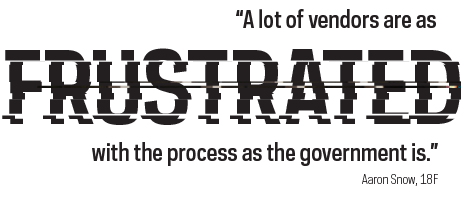


Tech firms are adopting a new language to win a shot at innovation contracts.
Mohana Ravindranath
Sharath Mekala’s two-person tech startup isn’t a textbook government contractor.
Village Defense, spawned through a startup incubator called 1776, develops a free app that lets neighbors send real-time alerts to one another if they notice suspicious activity. A premium version, which costs $125 a month, is designed for homeowners associations.
A Washington area native, Mekala recently uprooted from Atlanta and returned to D.C., in part to market Village Defense to behemoth potential customers: the Defense Department, the Federal Emergency Management Agency and the Education Department. He says President Obama’s public safety initiative, which includes a blueprint for improved community policing, creates an opportunity for apps like Village Defense.
“I think the government is trying to keep up with [technology]... earlier on you’d have to push your way in,” Mekala says.

Federal procurement, once largely unapproachable by startups, could be transforming to let small, creative tech companies in. New efforts across government aim to reduce the time it takes to compete and award contracts and to chunk large federal tech projects into modules, potentially attracting businesses previously deterred by the lengthy procurement process.
While he has yet to land a contract, Mekala is part of a group of entrepreneurs hoping to take a bite of the apple. Still, he and others remain skeptical that new contracting models will immediately clear a path for new entrants hoping to cross over from the private sector.
The House Small Business Committee recently found that the number of small companies registered to do business with the federal government has declined by more than 100,000 since 2012. And for many new entrants, getting on a government procurement schedule is “simply a license to hunt,” says Trey Hodgkins, senior vice president of the Information Technology Alliance for Public Sector. “It doesn’t mean you’re going to get
any business.”
Tech Talent Transfer
The federal government has often looked to the private sector for new ideas. Last year, senior executives from Google, Amazon, Twitter and other tech giants have joined government, including White House Chief Technology Officer Megan Smith, former vice president of the Google X moonshot lab. This spring, the Pentagon opened an office in the San Francisco area—the Defense Innovation Unit Experimental—in an attempt to absorb some of Silicon Valley’s tech talent.
Some efforts are explicitly aimed at attracting a host of new contractors to government. The Defense Advanced Research Projects Agency is piloting a program that lets robotics tinkerers bid on contracts for bits of hardware and software, each lasting six to 12 months and costing about $150,000. In its fiscal 2016 budget request, the Office of Management and Budget proposed to simplify the contracting process for awards under $500,000 and to pilot budgetary set-asides for small, cutting-edge companies.

Another effort, spearheaded by 18F—the General Services Administration’s roving tech team, many of whom are recruited from the private sector—aims to create a new contracting model for “agile delivery services.” This approach breaks IT projects into smaller chunks to ward off IT fiascos like the botched rollout of HealthCare.gov.
The new Blanket Purchase Agreement, unveiled in June, would let businesses on GSA’s Schedule 70 join a list of approved vendors specializing in agile services once they have demonstrated their ability—one way would be through a 24-hour product development challenge.
“The industry day we did for [the BPA] at the end of January was probably the most widely attended industry day in GSA history,” says Aaron Snow, 18F’s acting executive director. “And the feedback during that day was—and this was something we sort of already knew, but it was great to hear again—a lot of vendors are as frustrated with the process as the government is.”
The Blanket Purchase Agreement could cut the time from solicitation to contract to less than four weeks, according to an 18F blog post, and would also require delivery of a minimum viable product within three months.
Better Market Access
An emphasis on “innovation” and “agile services,” among other tech buzzwords, is attracting new players to the government space, says Meagan Metzger, founder of a new Washington-based program to coach startups on federal contracting. The program, called Dcode42, claims to be able to give companies with no access to the government “full access” in six months in exchange for equity or for a fee of $130,000 to $170,000.
Metzger is assessing applicants for the inaugural class, starting in August—about 30 startups have applied for 10 spots. Some applicants are considering pivoting from the commercial space to the public sector in response to “the mind-set coming out of 18F and the U.S. Digital Service,” she says.
Andrew Chang, managing partner at government-focused startup incubator Eastern Foundry, based in Arlington, Virginia, said most members are excited about new opportunities to sell to the government, but they also are cautious about placing too much stock in agile services.
“A big chunk of that [excitement] started when Ash Carter went to Silicon Valley,” Chang says. But, he adds, “it’s hard [for] these innovative tech companies full of engineers . . . trying to get contracts” for the first time.

To keep up with a perceived demand for agile services, Chang says, some more experienced contractors are “trying to rebrand themselves as more agile—‘better than the big boys, but [you] don’t have to deal with all the bureaucracy of the big boys.’ ”
Chris Worden, chief executive of Worden Technology Solutions, which operates out of Eastern Foundry, is less optimistic about new opportunities in contracting. His 12-person IT company, incorporated in 2011, subcontracts with the Defense Department and other federal agencies and is applying for a spot on GSA’s Schedule 70 for information technology products and services. Worden is working on a network and server consolidation project for the DOD.
Worden says he makes a special effort to hire employees who can juggle multiple projects at once and switch tasks often—employees who can thrive in an agile environment. And in conversations with the federal government and prime contractors, Worden says he plays up the company’s “agile” capabilities in an attempt to gain more interest.
Though modular contracts could create more opportunities to bid, Worden says they also bring inherent uncertainty, especially because there’s no guarantee that a contractor will continue to work on a project after the first phase.
To offset the risk of lost contracts, for the first time in years he plans to search for private sector clients.
Sizing Up Security Risks
Some critics, including Wes Bush, chief executive of giant defense contractor Northrop Grumman, warn the federal government against preoccupation with commercial developments at the risk of compromising security.
“In today’s framework of very tight budgets . . . there is a very understandable desire to find something that feels like a cheaper alternative to defense R&D,” he said during a recent speech at the Center for Strategic and International Studies. But commercial solutions might not be as secure as defense technology, Bush said, and “are not the answer to our national security need for technological superiority, and therefore should not be used as an excuse for further reductions in R&D.”
But Andre Gudger, acting deputy assistant secretary of Defense for manufacturing and industrial base policy, says that especially in sectors such as consumer electronics “the technology is evolving so fast, DOD can benefit by being a commercial buyer, so we can buy products faster.”

He pointed to examples such as Bedford, Massachussetts-based iRobot, which makes vacuum-cleaning robots. The company, which has about 500 employees, received a federal Small Business Innovation Research grant several years ago. The Defense Department later awarded the company a contract for unmanned robotic vehicles that can remotely test for, and dispose of, explosive devices. Last year, DOD awarded iRobot a $54 million modification to that earlier contract.
Gudger says Defense has been issuing six solicitations annually, up from five a few years ago, to cutting-edge small businesses through SBIR and the Small Business Technology Transfer Program. Both funding programs target emerging technology. About 24 percent of respondents have never done business with the Defense Department, Gudger says.
Despite pockets of support for small businesses among agencies, many of these efforts are still nascent and the federal market isn’t yet an inviting place for commercial startups, according to Deloitte Federal analyst Beth McGrath.
“The challenge still is overcoming the cultural aspects of acquisition and making sure that there’s an appropriate level of checks and balances in place, coupled with the right amount of transparency,” she says. “We’re all still struggling with ‘what does the right balance look like.’ ”

Mohana Ravindranath covers civilian agency technology and IT policy for Nextgov. She previously covered IT for The Washington Post, and her work has also appeared in Business Insider and The Philadelphia Inquirer.